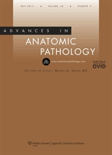
ADVANCES IN ANATOMIC PATHOLOGY
Scope & Guideline
Exploring the Depths of Pathological Science.
Introduction
Aims and Scopes
- Molecular Pathology:
The journal emphasizes advancements in molecular pathology, particularly in the context of cancer diagnostics and treatment, including various tumor types and their genetic alterations. - Diagnostic Innovations:
There is a consistent focus on innovative diagnostic techniques, including immunohistochemistry, artificial intelligence, and other emerging technologies that enhance the accuracy and efficiency of pathological assessments. - Tumor Classification and Grading:
The journal covers updates in tumor classification systems, grading methodologies, and the clinical implications of these classifications, providing insights into prognostic factors and treatment responses. - Multidisciplinary Approaches:
There is a strong emphasis on the importance of multidisciplinary collaboration in pathology, particularly concerning the integration of clinical, radiological, and molecular data for comprehensive patient management. - Emerging Tumor Entities:
The journal highlights newly recognized tumor types and entities, along with their histopathological characteristics, molecular features, and clinical significance, reflecting ongoing developments in the field.
Trending and Emerging
- Artificial Intelligence in Pathology:
The integration of artificial intelligence in diagnostic pathology is becoming increasingly prominent, highlighting its potential to enhance diagnostic accuracy and streamline workflows. - Molecular Subtyping of Tumors:
There is a growing emphasis on molecular subtyping and genetic characterization of tumors, which aids in personalized medicine and targeted therapies, reflecting a shift towards precision oncology. - Immuno-oncology and Biomarkers:
Research on immunotherapy-related biomarkers and immune profiling is on the rise, underscoring the role of pathologists in the context of immuno-oncological treatments and patient management. - Social Media's Role in Pathology Education:
The exploration of social media platforms for pathology education and professional development indicates a trend towards leveraging digital tools for knowledge dissemination and community engagement. - Challenges in Thoracic Pathology:
Recent discussions surrounding the challenges in thoracic pathology, particularly regarding lung cancer diagnostics and treatment, reflect a focused interest in addressing complex cases and advancing clinical practice.
Declining or Waning
- Traditional Histopathology Techniques:
There is a noticeable decline in papers focusing solely on traditional histopathological techniques without integration of molecular or technological advancements. - General Cancer Reviews:
Papers providing broad overviews of cancer types without specific focus on novel findings, diagnostic criteria, or molecular insights are less frequent, as the journal shifts towards more specialized and detailed studies. - Non-Molecular Tumor Markers:
The use of conventional tumor markers that do not incorporate molecular pathology insights appears to be decreasing, as the field increasingly prioritizes molecular diagnostics for better prognostic and therapeutic implications.
Similar Journals

VIRCHOWS ARCHIV
Connecting Researchers to the Heart of Pathological ScienceVirchows Archiv, published by Springer, is an esteemed journal dedicated to the fields of Medicine and Pathology, featuring high-quality research from various domains including Cell Biology and Molecular Biology. With its inception dating back to 1947, Virchows Archiv has been a pivotal platform for advancing the understanding of pathological and forensic medicine. As evidenced by its impressive Scopus rank, placing it within the top 15% of journals in Pathology and Forensic Medicine, it continues to maintain a strong presence with a Q1 classification in its category as of 2023. Although it does not offer Open Access options, the journal remains critical for researchers and professionals seeking to publish and access pioneering findings that can impact clinical practices and the academic community. The journal’s rigorous peer-review process ensures that only the highest quality research is disseminated, making it an essential resource for those engaged in the ever-evolving fields of health and biological sciences.
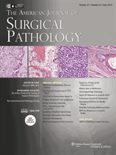
AMERICAN JOURNAL OF SURGICAL PATHOLOGY
Shaping the Future of Surgical Pathology TogetherThe American Journal of Surgical Pathology, published by Lippincott Williams & Wilkins, is a premier peer-reviewed journal serving as a vital resource for pathologists, surgeons, and researchers in the medical field. With an impressive impact factor reflective of its esteemed standing in the academic community, the journal ranks in the Q1 quartile for Anatomy, Pathology and Forensic Medicine, and Surgery as of 2023. The journal's Scopus rankings further highlight its significance, placing it within the top tiers in multiple medical disciplines. Established in 1977 and continuing through 2024, its scope encompasses groundbreaking research, critical reviews, and updates in surgical pathology, making it an essential tool for advancing the scientific community's understanding of disease mechanisms and therapeutic approaches. Researchers, clinicians, and students will find both comprehensive studies and innovative insights, ensuring they remain informed about the latest developments in surgical pathology.

Diagnostic Pathology
Championing Excellence in Pathology and Histology StudiesDiagnostic Pathology is a prominent open-access journal published by BMC, dedicated to advancing the field of pathology by providing a platform for high-quality research findings since its inception in 2006. Based in the United Kingdom, the journal covers a broad spectrum of topics within the realms of histology, pathology, and forensic medicine, facilitating discussions that are crucial for both clinical and laboratory settings. With an impressive impact factor that places it in the Q2 category across multiple categories including Histology and Miscellaneous Medicine, it ranks favorably in Scopus with notable positions in the 71st and 55th percentiles for Pathology and Histology respectively. As a valuable resource for researchers, professionals, and students alike, Diagnostic Pathology promotes the dissemination of cutting-edge studies and findings, thereby contributing significantly to the evolving landscape of medical science. The journal’s commitment to open access enhances its accessibility, ensuring that valuable research is freely available to a global audience.
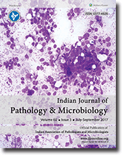
Indian Journal of Pathology and Microbiology
Empowering Global Scholars in MicrobiologyIndian Journal of Pathology and Microbiology, published by Wolters Kluwer Medknow Publications, is a distinguished open-access journal that has been fostering knowledge dissemination in the fields of pathology and microbiology since 2008. With an ISSN of 0377-4929 and E-ISSN 0974-5130, this journal serves as a critical resource for researchers and practitioners committed to advancing their understanding of medical sciences in India and beyond. Spanning decades of valuable research contributions since its establishment in 1972, it provides a platform for peer-reviewed articles that explore current trends and innovations in medicinal pathology and microbiological studies. Although it holds a Q4 ranking in categories such as medicine and microbiology, it maintains a notable Q3 classification in pathology and forensic medicine, highlighting its relevance to contemporary scientific discussions. Accessible freely to a global audience, the journal plays a pivotal role in enhancing scholarly communication and collaboration, making it an indispensable tool for students, professionals, and researchers alike aiming to contribute to this evolving discipline.

HISTOLOGY AND HISTOPATHOLOGY
Pioneering Research in Histology and PathologyHISTOLOGY AND HISTOPATHOLOGY, published by F HERNANDEZ, is an esteemed academic journal dedicated to advancing the fields of histology and pathology. With its ISSN 0213-3911 and E-ISSN 1699-5848, this journal has been a crucial resource for researchers and professionals since its inception in 1986. The journal enjoys a strong reputation, evidenced by its Q2 category rankings in both Histology and Pathology & Forensic Medicine as of 2023, positioning it within the top tier of scholarly publications. With Scopus rankings placing it at Rank #74/208 in Medicine - Pathology and Forensic Medicine and Rank #31/62 in Medicine - Histology, it proves to be an essential platform for disseminating significant research findings and innovations. Although the journal is not open access, it is committed to providing high-quality, peer-reviewed articles that cater to the needs of its academic community. With a focus on fostering a deeper understanding of tissue structure and disease mechanisms, HISTOLOGY AND HISTOPATHOLOGY serves as an indispensable resource for students, researchers, and practitioners alike, facilitating the exchange of knowledge and pioneering research in these vital areas of study.

Pathologie
Advancing the Frontiers of Pathology and Forensic MedicinePathologie is a distinguished academic journal published by Springer Heidelberg, dedicated to advancing the field of pathology and forensic medicine. With an ISSN of 2731-7188 and an E-ISSN of 2731-7196, this journal serves as a vital platform for researchers, professionals, and students to disseminate innovative findings and insights. Currently ranked in the Q3 category of pathology and forensic medicine according to the 2023 metrics, Pathologie reflects a commitment to quality and relevance in a dynamic research landscape. Despite its relatively recent establishment from 2022, the journal is gaining traction with a Scopus rank of 139 out of 208 in its category, positioning itself as an emerging resource within the academic community. While it operates under a subscription model, the importance of the journal lies in its objective to facilitate the exploration of diverse pathological processes and enhance forensic methodologies, ultimately improving clinical outcomes and investigative practices. As it continues to grow, Pathologie stands poised to impact the pathology domain significantly.

Brain Tumor Pathology
Bridging research and practice in brain tumor pathology.Brain Tumor Pathology is a pivotal peer-reviewed journal published by SPRINGER JAPAN KK, focusing on the intricate and evolving field of brain tumor research. Established in 1997, the journal serves as a crucial platform for disseminating research findings, clinical studies, and reviews that advance our understanding of brain tumors and their pathology. With a notable impact factor, it ranks in the Q2 and Q3 quartiles in multiple categories, including Cancer Research, Medicine (miscellaneous), Neurology (clinical), and Oncology, reflecting its significance in enhancing scientific discourse and clinical practice. The journal is indexed by major databases, making it accessible to a wide audience of researchers, clinicians, and students who are dedicated to unraveling the complex mechanisms of brain tumors. Although it does not currently offer open access, its comprehensive articles and studies contribute to the vital conversation on brain tumor pathologies, treatment prospects, and innovation in the field. Researchers and professionals alike will find the insights and advancements presented in Brain Tumor Pathology indispensable for guiding future studies and improving clinical outcomes.
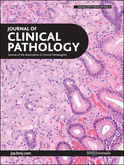
JOURNAL OF CLINICAL PATHOLOGY
Empowering Pathologists with Cutting-edge ResearchJOURNAL OF CLINICAL PATHOLOGY, published by BMJ PUBLISHING GROUP, stands at the forefront of advancements in the field of clinical pathology, offering a platform for groundbreaking research and insights from 1948 to the present. With an impressive impact factor and categorized as Q1 in both Medicine (miscellaneous) and Pathology and Forensic Medicine for 2023, the journal holds a distinguished position in the academic community, ranking 22nd out of 208 journals in its category on Scopus and representing the 89th percentile. While the journal does not currently offer open access, it remains a vital resource for researchers, healthcare professionals, and students seeking to stay current with innovative methodologies, clinical techniques, and diagnostic advancements. Located in London, United Kingdom, the journal aims to bridge the gap between laboratory findings and clinical practice, emphasizing the importance of evidence-based pathology in improving patient care and treatment outcomes. Engage with the JOURNAL OF CLINICAL PATHOLOGY to enhance your understanding and contribute to the evolving landscape of clinical pathology research.
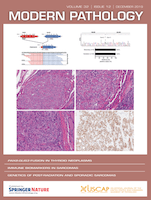
MODERN PATHOLOGY
Championing Rigor in Pathological ResearchMODERN PATHOLOGY is a premier journal in the field of pathology and forensic medicine, published by Elsevier Science Inc. With an impressive impact factor that places it in the top 1st quartile (Q1) for 2023, and a remarkable rank of 5 out of 208 in its category according to Scopus, it serves as a vital resource for researchers, professionals, and students alike. Established in 1988, the journal focuses on the latest advancements in diagnostic pathology, molecular pathology, and related fields, providing a platform for innovative research that drives the discipline forward. Although it does not operate under an open access model, readers can expect rigorously peer-reviewed publications that contribute to the growing body of knowledge in pathology. With a continuous commitment to excellence and relevance, MODERN PATHOLOGY remains a fundamental avenue for disseminating high-quality scientific research globally, facilitating the growth and development of its field.

Oral & Maxillofacial Pathology Journal
Transforming Clinical Practices in Oral HealthOral & Maxillofacial Pathology Journal is a prominent peer-reviewed publication dedicated to advancing the field of oral and maxillofacial pathology. Published by the KAIRALI SOCIETY OF ORAL & MAXILLOFACIAL PATHOLOGISTS, this journal aims to provide a platform for sharing innovative research, clinical practices, and new techniques related to the diagnosis and management of oral diseases. With a commitment to open access, it ensures that valuable knowledge reaches a global audience of researchers, dental professionals, and students alike. Although specific impact metrics such as the HIndex and Scopus ranking are not listed, the journal is regarded as an essential resource for those involved in the oral health community. It plays a crucial role in fostering collaboration and disseminating cutting-edge advancements that can enhance patient care and clinical outcomes in oral pathology. For professionals looking to stay ahead in this dynamic field, Oral & Maxillofacial Pathology Journal serves as an indispensable tool for both foundational learning and advanced research.